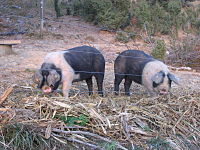
Photo from wikipedia
Typical salami produced from Mora Romagnola (MR), an autochthonous pig breed extensively farmed within a geographically confined Italian area, are food products of commercial interest. This investigation aimed to highlight… Click to show full abstract
Typical salami produced from Mora Romagnola (MR), an autochthonous pig breed extensively farmed within a geographically confined Italian area, are food products of commercial interest. This investigation aimed to highlight elements for the recognition and authentication of such typical salami. Five MR salami were analyzed using a sensory and instrumental approach, and the results were compared with those from eight salami made from a conventional pig breed. The sensory profiles were defined through attributes such as seasoning, pepper, garlic, fermented etc.; no differences in the products ascribable to the pig breed were highlighted. By analyzing volatile compounds, 33 molecules were detected; significant differences were found among samples, probably related to processing methods. Color differences between MR and conventional salami were identified by an electronic eye. According to instrumental texture analysis, large variability among the MR samples was detected, probably related to different types of salami (recipe, casing, size, ripening). Correlations were found among the sensory results, volatile compounds, and textural properties of the samples. Most differences do not appear to be specifically related to MR breed; only red color intensity evaluated by an electronic eye showed a correlation with breed, i.e., MR salami. This study highlights the large variability among the salami analyzed.
Journal Title: Foods
Year Published: 2022
Link to full text (if available)
Share on Social Media: Sign Up to like & get
recommendations!